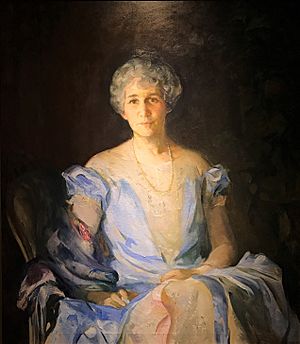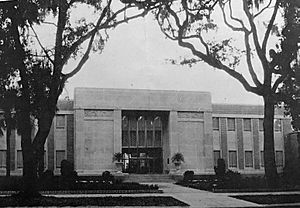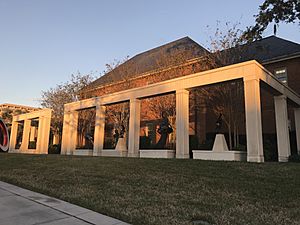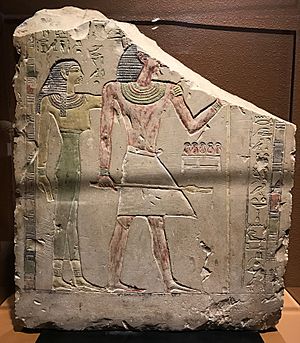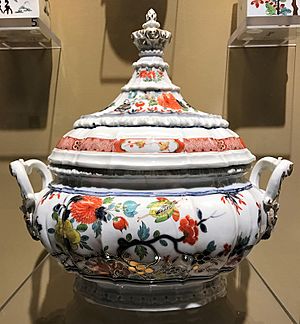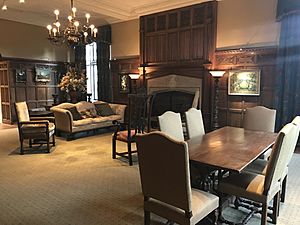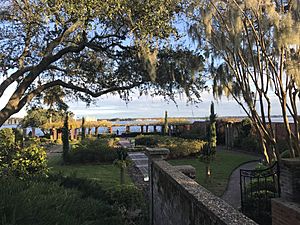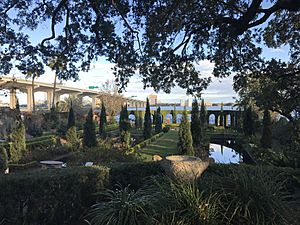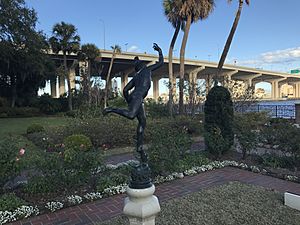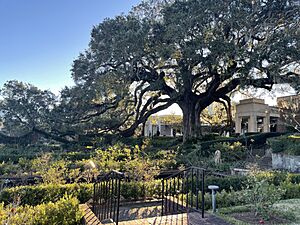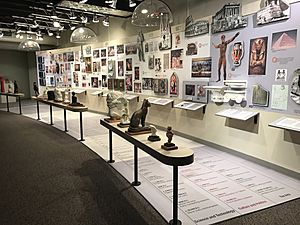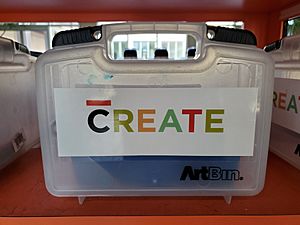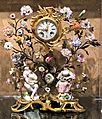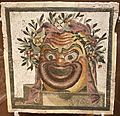Cummer Museum of Art and Gardens facts for kids
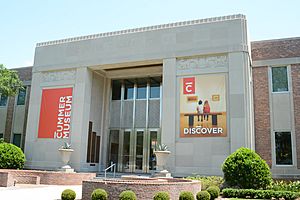
Entrance to the Cummer Museum
|
|
| Lua error in Module:Location_map at line 420: attempt to index field 'wikibase' (a nil value). | |
| Former name | The Cummer Gallery |
|---|---|
| Established | November 11, 1961 |
| Location | Jacksonville, Florida |
| Type | Art museum |
| Accreditation | American Alliance of Museums |
| Collection size | 6000 |
| Visitors | 130,000 annually |
| Founder | Ninah Cummer |
| Public transit access | Bus: R5, WS12 |
| Nearest parking | Across the street (no charge) |
The Cummer Museum of Art and Gardens is an exciting museum located in Jacksonville, Florida. It opened in 1961, thanks to Ninah Cummer. She loved art and gardens, and when she passed away, she left her amazing collection and beautiful gardens to start this museum.
The museum has grown a lot since then. It now includes land that belonged to Ninah's brother-in-law. But don't worry, you can still see her original garden designs and even a part of her old home with its historic furniture! About 130,000 people visit the museum and gardens every year.
The museum's main art collection has over 5,000 pieces. These artworks span a huge amount of time, from 2100 BCE all the way to today. You'll find many European and American paintings here. There's also a special collection of Meissen porcelain, which is a type of fancy pottery. The museum also has a fantastic education center called Art Connections. It has fun, interactive exhibits and helps students, especially those who might not otherwise get to experience art.
Outside, there are three beautiful flower gardens. The oldest one was created over 120 years ago! These gardens have kept their original look for more than a century. Famous landscape designers like the Olmsted Brothers helped create them. The Cummer Gardens are so special that they are listed on the National Register of Historic Places.
Contents
Discovering the Museum's Past
The Cummer Family Story
The story of the Cummer Museum began in 1902. That year, Arthur and Ninah Cummer built their home in Jacksonville. Arthur's parents and brother lived nearby. Arthur's father, Wellington Cummer, was a very rich lumber businessman. His company once owned the most land in Florida!
In 1906, Ninah and Arthur bought their first piece of art while on their honeymoon. It was a painting called Along the Strand by Paul King. It shows two men riding horse-drawn carts on a beach. Later, in 1931, Ninah hired a landscape designer named Ellen Biddle Shipman to create the beautiful Italian Garden on her land.
After Arthur passed away in 1943, Ninah Cummer started collecting even more art. In 15 years, she gathered 60 amazing artworks. All of these pieces are still part of the museum's collection today. Ninah wanted her gifts to be "a small beginning toward a large vision." She hoped others would help create a "center of beauty and culture" for the community. She set up a foundation to make her dream come true.
How the Museum Began
Ninah Cummer passed away in 1958. She left her home and gardens to the foundation she created. Her wish was for a museum to display her art. In 1960, the Cummer family homes were taken down to build the new museum. The new building was designed in 1961. It had a cool Art Deco style front. One special room from the original Cummer home, called the Tudor Room, was saved and moved into the new museum.
The Cummer Museum of Art & Gardens, first called The Cummer Gallery, opened its doors on November 11, 1961. One thousand guests attended the opening, including the mayor of Jacksonville and the governor of Florida. They all praised the museum as a wonderful gift to the city. The museum showed Ninah's collection and other special art exhibits.
In 1971, the museum added a new section for art from the 1600s. In 1989, the museum got an ancient Egyptian stone carving, or stela, from 2100 BCE. This became the oldest piece of art in their collection!
In the early 1990s, the museum expanded again. They added the Barnett building, which became the Art Connections education center. This expansion was finished in 1992. In 2002, the museum bought another building, the Woman's Club of Jacksonville. It was planned to be a space for museum programs.
On January 25, 2010, the beautiful Cummer Gardens were officially added to the National Register of Historic Places. Sadly, in 2016, the Woman's Club building had to be taken down because of termite damage.
Exploring the Art Collection
The Cummer Museum's art collection has grown a lot. It started with Ninah Cummer's 60 artworks and now has over 5,000 pieces! The collection covers art from 2100 BCE to today. You can see works by famous artists like Peter Paul Rubens, Winslow Homer, and Norman Rockwell.
The museum also has the Wark Collection of Early Meissen Porcelain. Many artworks are donated to the museum, like the Wark collection. Others are bought using special funds.
Special Art Collections
The Cummer Museum has seven special collections:
- The Constance I. and Ralph H. Wark Collection of Early Meissen Porcelain – This collection has over 700 pieces of beautiful Meissen porcelain. Ralph Wark started collecting it in 1922 and donated it to the museum in 1965.
- The Eugène Louis Charvot Collection – Over 200 artworks by Eugène Louis Charvot, a French doctor and painter.
- Joseph Jeffers Dodge Collection – 230 works by American artist Joseph Jeffers Dodge.
- The Dennis C. Hayes Collection of Japanese Prints – A collection of 190 Japanese prints from the 1800s and 1900s.
- The James McBey Collection – One of the largest collections of James McBey's art outside of Scotland.
- The Eugene Savage Collection – Art by Eugene Savage that shows Seminole traditions from the 1930s.
- Permanent Collection Archives and Rare Books – Old documents and rare books that go along with the other collections. This includes some of the Cummers' own books.
The Tudor Room
One special room from the original Cummer home, called the Tudor Room, was saved. It lets visitors see what the Cummer family's home was like. It still has all its old furniture and some paintings from the Cummers' first art collection. You can also see portraits of Ninah and Arthur Cummer here.
Outdoor Sculptures
Many sculptures from the museum's collection are displayed outside in the gardens. You can find Janet Scudder's Running Boy in the courtyard. Riis Burwell's Entropy Series #26 is above the Italian Garden. A statue of Mercury stands in the middle of the Olmsted Garden. Diana of the Chase by Anna Hyatt Huntington is in the upper part of the gardens. There's also a sculpture garden around the Barnett building.
The Beautiful Gardens
The Cummer Gardens cover about 1.45 acres. They feature native Florida plants, huge live oak trees, and pretty reflecting pools, fountains, and sculptures. The gardens are divided into three themed areas and a large lawn by the St. Johns River. Many old trees were cut down for flower beds, but some grew to be 150 feet tall! Ninah Cummer loved lions, and you can find lion details all over the gardens.
The first gardens were designed in 1903. Later, Thomas Meehan & Sons redesigned one garden in 1910, which became the English Garden. Ellen Biddle Shipman designed the Italian Garden in 1931. The Cummer Gardens are on the National Register of Historic Places because they show how American landscape design changed in the early 1900s.
You can even take a virtual tour of the Cummer's gardens on their website! This lets you explore the gardens, learn about the plants, and see the sculptures from anywhere.
In September 2017, Hurricane Irma caused a lot of damage to the gardens. The St. Johns River overflowed, flooding the gardens with about four feet of water. A big project to fix the English, Italian, and Olmsted Gardens started in December 2018 and finished in June 2019. The restoration used old records, photos, and plans to make sure the gardens looked just like they used to. All three gardens were open to the public again by July 2019.
The English Garden
The English Garden is a rectangular garden with brick paths. It has a pergola with cypress trees and many statues. The garden is full of native trees, shrubs, and flowers, especially beautiful azaleas. There's also a wall garden built in 1922. A large wisteria arbor is the main feature of this garden.
Thomas Meehan & Sons designed the English Garden in 1910. It was first called the Wisteria Garden. Ninah Cummer became very interested in azaleas in 1925. She replanted much of her English garden with them, renaming it the Azalea Garden.
The Italian Garden
Ellen Biddle Shipman designed the Italian Garden in May 1931. It has two rows of trimmed evergreen trees between two long, rectangular reflecting pools. At the end of the garden, there's a beautiful marble fountain surrounded by an arched structure called a gloriette. You'll also see statues, ornaments, and pots of small trees and flowers.
In 2002, the original fountain was replaced. A new one, made of Botticino marble, was sculpted in Italy to look exactly like the old one.
The Olmsted Garden
The Olmsted Garden was designed by the Olmsted Brothers. They were the sons of Frederick Law Olmsted, who designed Central Park in New York City! This garden was behind Waldo and Clara Cummer's home. It has many kinds of flowers and trees, a curved staircase, and three garden rooms.
After the property was sold in 1960, the garden became overgrown. But when the Barnett building was bought, plans were made to restore it using old photos. The garden was brought back to its original look in 2013. The main feature of the garden is a bronze statue of Mercury. The statue was given away in the 1960s but was donated back to the museum around 2013.
The Cummer Oak
The Cummer oak is a giant live oak tree that stands proudly over the gardens. It's thought to be between 400 and 450 years old! This amazing tree is 80 feet tall and spreads 138 feet wide. Its trunk is 21 feet around.
Learning and Fun at Art Connections
The museum's expansion in 1992 created space for a new education center called Art Connections. This center has given thousands of local schoolchildren a chance to learn about art. They get hands-on experiences, art classes, and special tours. In 1994, Art Connections even won a national award for its great community service!
Art Connections got a big makeover in 2004. They added new, high-tech activities. Imagine a virtual canvas where you paint with a laser-light paintbrush! There's also a room that turns your dancing shadows into art on the wall.
Art Connections offers many educational programs. These include Women of Vision, Junior Docents, and the Weaver Academy of Art.
The Very Special Arts Festival is an annual event for special education students. It's hosted at the Cummer Museum. In 2014, over 2,000 students and 1,000 volunteers participated! Students work on hands-on art projects, and some of their art has even been displayed in the museum.
The Weaver Academy of Art started in 2007. It helps elementary school children who might not otherwise get art education. This program serves more than 3,000 students and 200 teachers in the area. It's the biggest educational program at the Cummer Museum. It provides museum tours, classroom visits, teacher training, and free passes for students and teachers.
Families with young children can pick up a Family Backpack from the Art Connections center. These backpacks have materials and activities for younger visitors. They help families discover and understand art while exploring the museum. Family Backpacks are available in themes like Animals, Color Splash, Gardens, and My Family.
You can also create your own art while exploring the galleries and gardens! Just visit the CREATE Cart. On the cart, you'll find boxes with a clipboard, paper, and colored pencils. You can check out these boxes for free and return them to the cart when you're done.
Images for kids
-
Winslow Homer, Waiting for a Bite, c. 1874
-
Thomas Moran, Ponce de León in Florida, c. 1877-1878
-
Workshop of Gian Lorenzo Bernini, Armand Jean du Plessis, Cardinal de Richelieu, c. 1641
-
Robert Henri, Guide to Croaghan (Brian O'Malley), c. 1913
-
Marie Victoire Lemoine, Portrait of Zamor, c. 1785
-
William-Adolphe Bouguereau, Return from the Harvest, c. 1878
See also
 In Spanish: Cummer Museum of Art and Gardens para niños
In Spanish: Cummer Museum of Art and Gardens para niños


